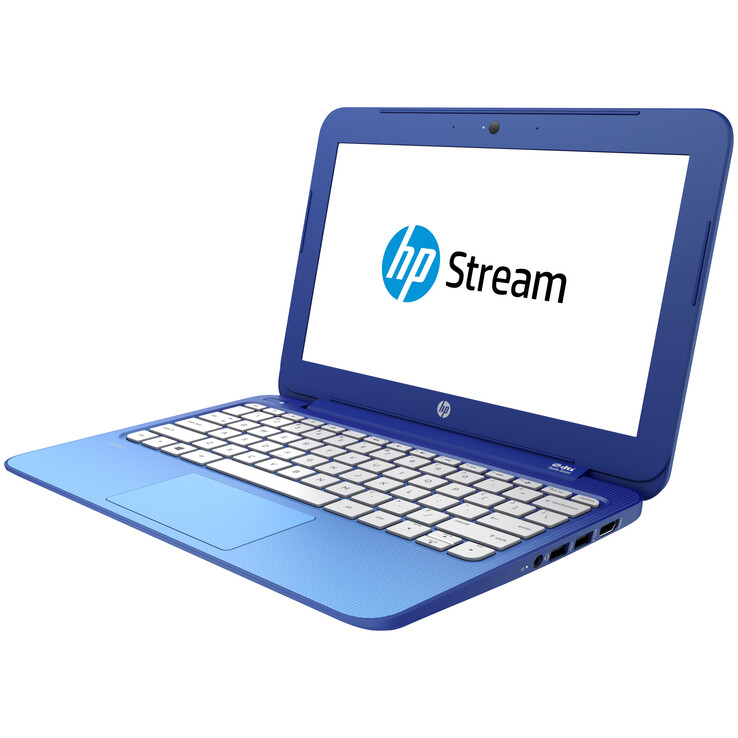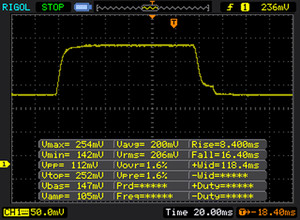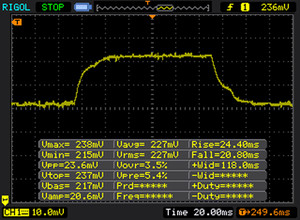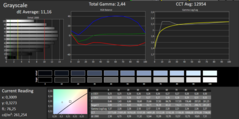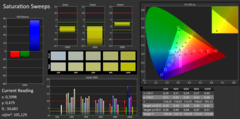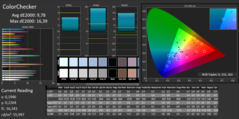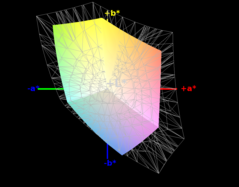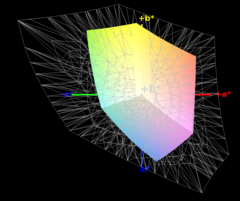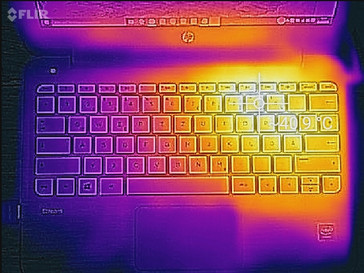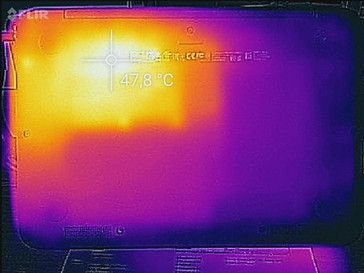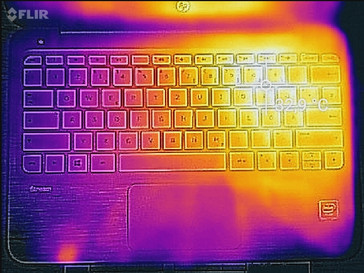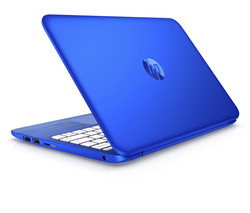HP Stream 11-r000ng Subnotebook Review

For the original German review, see here.
A few years ago, we had netbooks. Now we have 11.6-inch Windows laptops with decent performance. The biggest difference between these two generations: today we see Intel Braswell processors, like Celeron or Pentium, which are available for a small budget of 200 - 300 Euros (~$220 - ~$330). Furthermore, the new models use eMMC storage, which offer limited space for users to store their data. To balance out this drawback, manufacturers offer cloud storage, such as Microsoft OneDrive. As such, the Stream 11 test model only has 14 GB of local storage space!
The competition is sparse in this section, as customers are more interested in Windows convertibles with a higher price tag.
- Medion AKOYA S2218 (Atom Z, 2 GB, 64 GB, IPS FHD) 230 Euros (~$253)
- Lenovo S21e-20 (Pentium N3540, 2 GB, 32 GB, TN HD) 190 Euros (~$209)
- Acer Aspire Switch 10E SW3-013-13XS (Atom Z, 2 GB, 32 GB, IPS HD) 275-300 Euros (~$302 - ~$330)
- ASUS Transformer Book T100TAL (Atom Z, 2 GB, 32 GB, IPS HD) 210-250 Euros (~$231 - ~$275)
Display
| |||||||||||||||||||||||||
Brightness Distribution: 84 %
Center on Battery: 218 cd/m²
Contrast: 528:1 (Black: 0.5 cd/m²)
ΔE ColorChecker Calman: 9.78 | ∀{0.5-29.43 Ø4.78}
ΔE Greyscale Calman: 11.16 | ∀{0.09-98 Ø5}
63% sRGB (Argyll 1.6.3 3D)
41% AdobeRGB 1998 (Argyll 1.6.3 3D)
43.97% AdobeRGB 1998 (Argyll 3D)
63.5% sRGB (Argyll 3D)
42.52% Display P3 (Argyll 3D)
Gamma: 2.44
CCT: 12954 K
| HP Stream 11-r000ng CMN1131, TN, 1366x768, 11.6" | Medion Akoya S2218 AUO B116HAT03-2, IPS, 1920x1080, 11.6" | Lenovo S21e-20 80M4004MGE BOE NT116WHM-N11, TN, 1366x768, 11.6" | Acer Aspire Switch 10E SW3-013 AU Optronics AUO15D4, IPS, 1280x800, 10.1" | Asus Transformer Book T100TAL-DK021P AU Optronics B101XAN02, IPS, 1366x768, 10.1" | |
|---|---|---|---|---|---|
| Screen | 33% | -11% | 30% | 39% | |
| Brightness middle (cd/m²) | 264 | 417 58% | 240 -9% | 337 28% | 260 -2% |
| Brightness (cd/m²) | 248 | 394 59% | 225 -9% | 327 32% | 252 2% |
| Brightness Distribution (%) | 84 | 88 5% | 90 7% | 86 2% | 94 12% |
| Black Level * (cd/m²) | 0.5 | 0.43 14% | 0.61 -22% | 0.35 30% | 0.23 54% |
| Contrast (:1) | 528 | 970 84% | 393 -26% | 963 82% | 1130 114% |
| Colorchecker dE 2000 * | 9.78 | 6.7 31% | 11.23 -15% | 6.24 36% | 4.45 54% |
| Colorchecker dE 2000 max. * | 16.39 | 15.07 8% | 19.44 -19% | ||
| Greyscale dE 2000 * | 11.16 | 6.25 44% | 12.33 -10% | 5.74 49% | 3.41 69% |
| Gamma | 2.44 90% | 2.48 89% | 2.5 88% | 2.26 97% | 2.25 98% |
| CCT | 12954 50% | 5954 109% | 14130 46% | 7214 90% | 6761 96% |
| Color Space (Percent of AdobeRGB 1998) (%) | 41 | 46 12% | 39 -5% | 43 5% | 44 7% |
| Color Space (Percent of sRGB) (%) | 63 | 69 10% | 61 -3% | 67 6% |
* ... smaller is better
Display Response Times
| ↔ Response Time Black to White | ||
|---|---|---|
| 24 ms ... rise ↗ and fall ↘ combined | ↗ 8 ms rise | |
| ↘ 16 ms fall | ||
| The screen shows good response rates in our tests, but may be too slow for competitive gamers. In comparison, all tested devices range from 0.1 (minimum) to 240 (maximum) ms. » 53 % of all devices are better. This means that the measured response time is worse than the average of all tested devices (20.2 ms). | ||
| ↔ Response Time 50% Grey to 80% Grey | ||
| 44 ms ... rise ↗ and fall ↘ combined | ↗ 24 ms rise | |
| ↘ 20 ms fall | ||
| The screen shows slow response rates in our tests and will be unsatisfactory for gamers. In comparison, all tested devices range from 0.165 (minimum) to 636 (maximum) ms. » 73 % of all devices are better. This means that the measured response time is worse than the average of all tested devices (31.6 ms). | ||
Screen Flickering / PWM (Pulse-Width Modulation)
| Screen flickering / PWM not detected | ||
In comparison: 53 % of all tested devices do not use PWM to dim the display. If PWM was detected, an average of 8091 (minimum: 5 - maximum: 343500) Hz was measured. | ||
Performance
Processor
| Cinebench R15 | |
| CPU Single 64Bit | |
| Lenovo S21e-20 80M4004MGE | |
| HP x360 310 G1 | |
| HP Stream 11-r000ng | |
| CPU Multi 64Bit | |
| HP x360 310 G1 | |
| Lenovo S21e-20 80M4004MGE | |
| HP Stream 11-r000ng | |
System Performance
| PCMark 8 - Home Score Accelerated v2 | |
| HP Stream 11-r000ng | |
| Lenovo S21e-20 80M4004MGE | |
| Asus Transformer Book T100TAL-DK021P | |
| Medion Akoya S2218 | |
| PCMark 8 Home Score Accelerated v2 | 1487 points | |
Help | ||
Storage Device
| HP Stream 11-r000ng HD Graphics (Braswell), N3050, 32 GB eMMC Flash | Medion Akoya S2218 HD Graphics (Bay Trail), Z3735F, 64 GB eMMC Flash | Lenovo S21e-20 80M4004MGE HD Graphics (Bay Trail), N3540, 32 GB eMMC Flash | Acer Aspire Switch 10E SW3-013 HD Graphics (Bay Trail), Z3735F, 32 GB eMMC Flash | Asus Transformer Book T100TAL-DK021P HD Graphics (Bay Trail), Z3735D, 64 GB eMMC Flash | |
|---|---|---|---|---|---|
| CrystalDiskMark 3.0 | -22% | -3% | -17% | -41% | |
| Read Seq (MB/s) | 154.2 | 140.2 -9% | 175.5 14% | 167.6 9% 90.7 -41% | 95.7 -38% |
| Write Seq (MB/s) | 76.6 | 52.7 -31% | 69.1 -10% | 88.4 15% 54.7 -29% | 46.9 -39% |
| Read 512 (MB/s) | 165.8 | 98.4 -41% | 166.6 0% | 150.6 -9% 83.9 -49% | 82 -51% |
| Write 512 (MB/s) | 59.9 | 58.7 -2% | 50.1 -16% | 66.4 11% 46.4 -23% | 45.93 -23% |
| Read 4k (MB/s) | 18.25 | 15.25 -16% | 19.35 6% | 16.49 -10% 15.56 -15% | 14.32 -22% |
| Write 4k (MB/s) | 13.16 | 9.817 -25% | 11.12 -16% | 9.46 -28% 8.37 -36% | 4.187 -68% |
| Read 4k QD32 (MB/s) | 46.51 | 37.24 -20% | 52 12% | 42.66 -8% 39.38 -15% | 32.03 -31% |
| Write 4k QD32 (MB/s) | 13.21 | 8.734 -34% | 10.96 -17% | 11.16 -16% 10.38 -21% | 5.61 -58% |
Graphics Card
| 3DMark 11 - 1280x720 Performance GPU | |
| HP Stream 11-r000ng | |
| Lenovo S21e-20 80M4004MGE | |
| Asus Transformer Book T100TAL-DK021P | |
| Acer Aspire Switch 10E SW3-013 | |
| 3DMark 11 Performance | 412 points | |
Help | ||
Emissions & Energy
(±) The maximum temperature on the upper side is 42.7 °C / 109 F, compared to the average of 35.9 °C / 97 F, ranging from 21.4 to 59 °C for the class Subnotebook.
(±) The bottom heats up to a maximum of 41.3 °C / 106 F, compared to the average of 39.3 °C / 103 F
(+) In idle usage, the average temperature for the upper side is 26.5 °C / 80 F, compared to the device average of 30.8 °C / 87 F.
(+) The palmrests and touchpad are cooler than skin temperature with a maximum of 29.6 °C / 85.3 F and are therefore cool to the touch.
(±) The average temperature of the palmrest area of similar devices was 28.2 °C / 82.8 F (-1.4 °C / -2.5 F).
Speakers
Frequency diagram in comparison (Checkboxes above can be selected!)
Value 1: Pink Noise 100% Vol.; Value 2: Audio off
Power Consumption
| Off / Standby | |
| Idle | |
| Load |
|
Key:
min: | |
Pros
Cons
Verdict
The HP Stream 11-r000ng is a handy, mini subnotebook for a small budget. In contrast to most competitors, the model has decent input devices. The keyboard is especially comfortable to use. Although this is not a ThinkPad-level keyboard, it is still reliable and not as bad as the ones in the AKOYA S2218 and the Lenovo S21e-20. The run time is a good 8 hours and matches the offering of the AKOYA S2218. The Lenovo S21e-20 is the only model which lags behind at 4:22 hours.
The microphone assists with good recordings. The webcam is weak, but thanks to the good mic the device can be used comfortably for Skype calls. The subnotebook offers sufficient performance for office programs and online games. Thankfully, the overall performance is decent due to the eMMC storage. It matches the performance offered by the Lenovo S21e-20 (PCMark 8 Home). Furthermore, it trumps models which use an Intel Atom by 20-30%.
Sadly, the user cannot install many programs due to the limited storage space available (14 GB free) and if the user needs extra space, they must use a MicroSD card or a cloud storage service.
Limited storage space - that does not make the Lenovo S21e-20 a better pick. The test model offers a faster processor in the Pentium N3540 and the entire package costs 190 Euros (~$209) with a Windows 10 license. We also tested the Medion Akoya S2218 with an Intel Atom Z3735F (but 64 GB flash storage). The 11.6-inch device offers an IPS panel with a resolution of 1920x1080 pixels and is available for 230 Euros (~$253). The Acer Cloudbooks are also an alternative. They use weaker processors and have even smaller storage devices. The Acer Aspire One 14 AO1-431-C6QM would be a viable candidate at 240 Euros (~$264). This 14-inch device has a processor similar to that of the Lenovo S21e-20. Both of these models use a TN panel which has poor viewing angles. The Akoya S2218 is an exception in this section with its high-quality IPS screen. However it does use a weaker processor.
HP Stream 11-r000ng
- 07/10/2016 v5.1 (old)
Sebastian Jentsch




